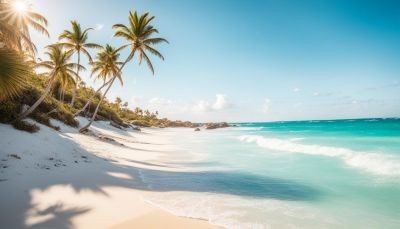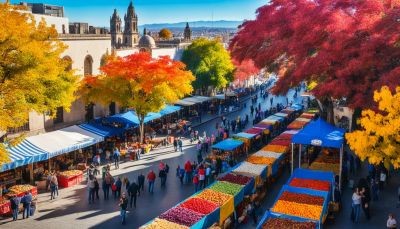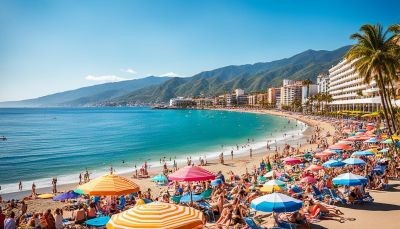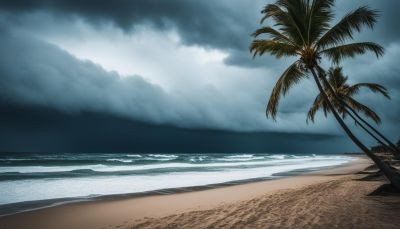Are you looking for a place that mixes culture, food, and great weather? Puebla, Mexico is it. This charming colonial city is becoming popular with smart tourists. Puebla offers amazing food, interesting places to visit, and a calm atmosphere. It's a top choice for a trip you won't forget. But, when is the best time to go for the weather?
Key Takeaways
- Puebla, Mexico offers a diverse range of cultural attractions and a thriving culinary scene.
- The fall months are the ideal time to visit Puebla, with pleasant temperatures and lower chances of rain and hurricanes.
- Traveling to Puebla during the low season allows you to avoid crowds and find better deals on accommodations and other expenses.
- Puebla's indoor attractions, such as museums and art galleries, provide excellent options for rainy days.
- The temperate weather in the fall makes it an excellent time to enjoy outdoor activities and explore Puebla's historical sites.
Understanding Puebla's Weather Patterns
When planning a trip to Puebla, Mexico, knowing its weather is key. You should look at how the seasons change, when it rains, and the highs and lows in temperatures. This info helps shape what you can do and see during your trip.Seasonal Climate Variations
Every season in Puebla brings something special. Winter is popular with visitors looking to avoid colder weather up north. But, autumn is also a great time to visit. The rains slow, and everything turns lush and green without getting damp all the time.Rainfall and Hurricane Season
Hurricane season spans from June to November in Mexico, hitting its peak in summer. Yet, when fall starts, the threat of big storms lessens. This means fall guests are less likely to face heavy rain or hurricane issues in Puebla.Temperature Ranges Throughout the Year
Fall in Puebla brings lovely weather, with mild temperatures and less moisture. Days reach about 75°F (24°C) and nights cool to about 55°F (13°C). This makes it perfect for exploring Puebla's culture and outdoor sites, avoiding both summer's fierce heat and winter's cold.Ideal Months for Pleasant Weather Conditions
The fall is a perfect time to visit Puebla, Mexico. It's the low season, so there will be fewer crowds. This means you can enjoy attentive service and have the attractions more to yourself.The weather in the fall is pleasant. You'll find fewer chances of rain and hurricanes than during the summer months.
| Best Months to Visit Puebla | Ideal Travel Months | Weather Conditions in Puebla |
|---|---|---|
| September - November | October - November | Mild temperatures, low rainfall, and low hurricane risk |
Avoiding the Peak Tourist Season
Traveling to Puebla in the fall is awesome. You avoid the winter peak tourist season. This means fewer crowds and more cultural attractions to enjoy, like the historic UNESCO Historic Centre and the beautiful Talavera ceramics. You can see everything without big tour groups. Plus, you can grab better deals on places to stay and other travel stuff.Fewer Crowds and Better Deals
In fall, Puebla becomes more yours to explore. There are fewer tourists. That means more chances to enjoy the local life without the crowd chaos. And you'll likely get better deals on hotels, food, and services. This helps you make the most out of your travel money.Exploring Puebla's Cultural Attractions
Fall in Puebla offers a calm time to appreciate its cultural attractions. You can stroll through the UNESCO-recognized Historic Centre and see its amazing colonial architecture. Admire the many churches with their unique styles and religious meanings. Don't miss the chance to explore the world of Talavera ceramics, which is key to Puebla's art scene.Budget-Friendly Travel Tips
Visiting Puebla in the fall can be budget-friendly. Many hotels and resorts have discounts then. This lets you find affordable accommodations. You can save more by trying the city's local cuisine, especially the famous mole poblano.Finding Affordable Accommodations
In Puebla, you can choose from various places to stay. Small boutique hotels to big resorts, there's something for everybody. Visiting in the off-peak season means you can find great deals on where to stay.Dining on Local Cuisine
To enjoy Puebla without emptying your wallet, try local food. Mole poblano and Talavera pottery are must-tries. You can get them cheap at local markets and from street vendors. It's a fun and budget-friendly way to eat around the city.Transportation Options
In Puebla, there are many ways to move around without spending too much. You can hop on a public bus or use cheap taxi services. These are very budget-friendly ways to travel within the city.Indoor Activities for Rainy Days
In Puebla, fall weather is mostly lovely, but it might rain sometimes. On rainy days, check out the city's indoor sites like museums and art galleries. For instance, the Cartesiano Hotel features an amazing lobby filled with art. It's a great place to see work by local artists.Don't forget about local markets. Profetica market is a must-see. It's like a huge store mixed with a library and hangout spot. You can find amazing books and Mexican crafts there. It's a fun way to spend a rainy day in Puebla.
Museums and Art Galleries
Don't let a little rain stop you from enjoying Puebla's cultural spots like museums and galleries. You can dive into the city's culture, seeing art from local and famous artists. It's a great way to learn about Puebla's creative world.Shopping at Local Markets
Local markets are a perfect spot when it's raining, including the Profetica market. Here, you can find unique crafts, books, and more. Meeting local sellers makes the experience even better. These places show Puebla's lively community and its special shopping scene.Puebla, Mexico: Best Months for a Weather-Savvy Trip
Puebla, Mexico shines in the fall months for travelers. It offers lovely weather, less rain and hurricanes, and fewer crowds. These conditions are perfect for enjoying Puebla's culture, food, and historic sites.The fall months in Puebla, Mexico let you dive into local life comfortably. You won't sweat in hot weather or dodge rain as in summer. This is great for those who like to plan their trips wisely.
Want to explore Puebla's rich cultural heritage or try unique foods? The fall season creates a magical setting for your journey. Enjoy the nice weather and the calm atmosphere to see all there is in Puebla.
Outdoor Adventures in Ideal Weather
During fall in Puebla, the weather is perfect for outdoor activities. You can walk the city's scenic hiking trails and nature reserves. These places offer beautiful green landscapes.The weather is also great for exploring Puebla's historical sites. One of these is the UNESCO-recognized Historic Centre. It has colonial architecture and old religious buildings.
Hiking and Nature Trails
Puebla is a paradise for those who love the outdoors. In fall, there are many hiking trails and nature reserves. The weather is cool, and you might not see much rain.Anybody can find a trail to enjoy, whether it's easy or hard. You'll see Puebla's green landscapes up close. It's a great way to spend time outside.
Exploring Historical Sites
Fall weather in Puebla is great for seeing historical places. The Historic Centre is UNESCO-recognized. It has old colonial buildings and churches.Walking around, you can see amazing cathedrals. This helps you learn about Puebla's long history.
Seasonal Events and Festivals
Visiting Puebla in the fall is a great idea. You'll see Mexico's culture at its best. September brings Mexican Independence Day. There's parades, music, and delicious food. These seasonal events and festivals let you dive into local traditions.Mexican Independence Day Celebrations
The celebrations in Puebla are special. You'll see lively parades and hear festive music. Fill your nose with the delightful scent of mole poblano. Everyone shows their love for Mexico in these Mexican Independence Day events.Day of the Dead Festivities
Later on, Puebla shines with the Day of the Dead festivities. It's a peek into the country's culture. This celebration remembers the departed with beautiful altars, music, and food. Join in this respectful yet joyful tradition.Packing for Your Weather-Savvy Trip
When you pack for your trip to Puebla, think about the changing weather. Days might be warm but nights can be cold, especially in high places. Pack light and warm clothes to stay comfortable all day.Remember to also bring some essential gear and accessories for your Puebla adventure. An umbrella or a raincoat is handy for when it rains. Even in fall, the high Mexican sun can burn your skin, so pack sunscreen.
With smart packing, you can enjoy Puebla's fall without worry. You'll be ready for any weather and have a great time. Get ready to explore the city's culture and join in the fun events.
Conclusion
Puebla, Mexico is perfect for a fall trip. It has great weather, less rain and hurricanes, and fewer people. This makes it ideal for enjoying the city's cultural heritage, tasty food, and lovely historic architecture.Plan your trip to Puebla in the fall for a cheaper and quieter visit. You can join in on the fun at seasonal events and festivals. These events highlight the best of Mexican culture, from Mexican Independence Day to Day of the Dead.
In Puebla, you can hike outside, learn about its history, and eat amazing food. This city has a lot to offer any curious traveler. So, consider visiting this lively Mexican city for an enriching experience.
FAQ
What are the best months to visit Puebla, Mexico?
The fall months make a perfect time to visit Puebla, Mexico. Rain and hurricanes occur less often. Pleasant temperatures and fewer visitors make exploring the city more enjoyable. This is also the time for vibrant events and festivals.
What is the weather like in Puebla during the fall?
Puebla's fall weather is nice with lower humidity and mild temperatures. Rain showers may happen, but not often. This makes it less rainy than in summer.
How can I avoid the peak tourist season in Puebla?
Choosing fall for your Puebla visit avoids the busy winter season. You'll find fewer tourists. This means enjoying the city's cultural sites like the historic UNESCO Historic Centre with ease. It can also save you money on accommodations during the off-season.
How can I have a budget-friendly trip to Puebla?
Skipping Puebla's fall season can save money. You'll find hotel discounts. Enjoy the local cuisine, like mole poblano, which costs less. Public transportation is cheaper than renting a car.
What can I do on rainy days in Puebla?
On rainy days, head inside Puebla's museums and galleries. Visit The Cartesiano Hotel to see local art. Explore markets like Profetica for books and crafts.
What outdoor activities can I enjoy in Puebla during the fall?
In Puebla’s fall, the weather is ideal for outdoor fun. Hike the city's trails and visit nature spots. The green landscapes are beautiful. This weather also suits visiting historical sites like the UNESCO Historic Centre.
What cultural events and festivals can I experience in Puebla during the fall?
Puebla's fall is full of cultural events. September features Independence Day celebrations with parades and food. The Day of the Dead festival showcases Mexican traditions later in the fall.
How should I pack for a trip to Puebla in the fall?
Pack layers for Puebla's fall days and cool nights. Light, breathable clothing is key. Don't forget an umbrella or raincoat for the occasional shower. And sunscreen to protect against the strong sun.











